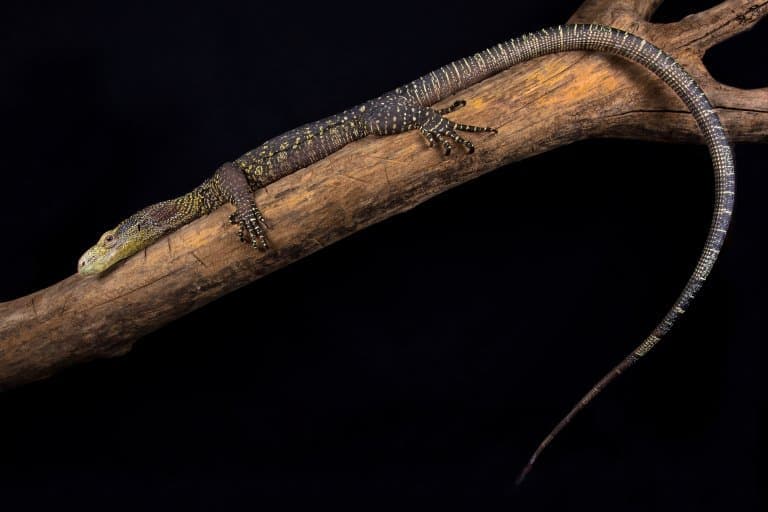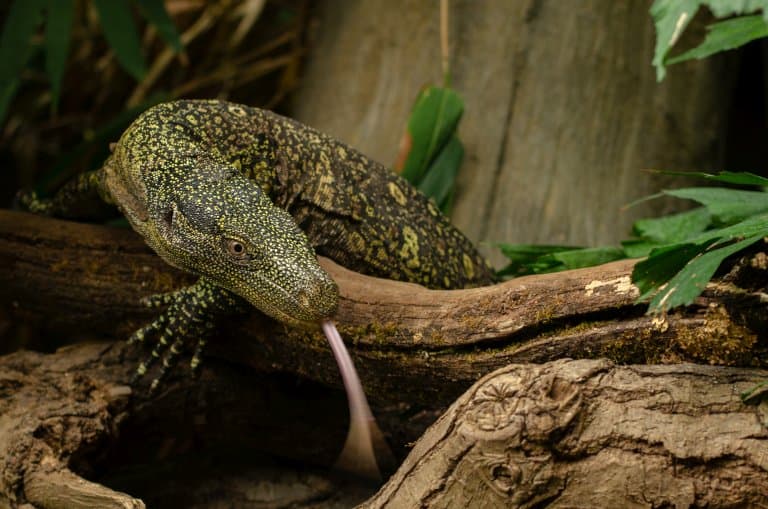Crocodile Monitor Profile
In the dense forests of Papua New Guinea, there’s an incredible prehistoric dragon: Artelia.
The third-largest lizard on Earth, known to local legends for its size, strength and ferocity, and yet shrouded in secrecy.
The Crocodile Monitor hasn’t lost much of its allure as a rare and lesser-known cousin of the Komodo Dragon.

Crocodile Monitor Facts Overview
| Habitat: | Dense lowland tropical forests |
| Location: | Papua New Guinea, Indonesia |
| Lifespan: | 20 years in captivity |
| Size: | Up to 2.65m (8.7ft) long |
| Weight: | Usually around 20kg. 90kg max. (44lb – 198 lb) |
| Color: | Mostly black, yellow, green and purple specks and stripes |
| Diet: | Mammals and reptiles, possibly birds |
| Predators: | Humans |
| Top Speed: | Unknown |
| No. of Species: |
1 |
| Conservation Status: |
Least Concern |
The crocodile monitor is also known as the Papuan monitor or Salvadori’s monitor and is the largest lizard in New Guinea, commonly reaching over 2.5m long.
Also called Artellia, it’s claimed to be able to walk on two legs and breathe fire, legends that are, to varying degrees, still unconfirmed.
Still, there’s a lot more than this left to discover about these elusive forest lizards. They’re hard to find and hard to breed, making for scarce literature on their behaviour and breeding habits.
At least they seem to be relatively unaffected by decline so far, and as generalist, multi-dimensional hunters, they’re likely to be resilient to change up to a point.
Interesting Crocodile Monitor Facts
1. They are one of the longest lizards in the world
It is New Guinea’s largest monitor lizard species (there are 7 in total), and one of the longest lizards in the world, measuring up to 2.5 m (8 feet) in length.
There are reports that some have been recorded to be longer than the komodo dragon, although not nearly as muscular or heavy.

2. They are all-terrain lizards
These monitors are generally terrestrial, but this is out of choice, rather than necessity. They’re competent swimmers, very comfortable in the water, and they’re known to be just as skilled in the branches.
Not much is known about their favourite foods, but birds are likely on the menu, and captive animals enjoy tall enclosures with lots to climb on, suggesting they would happily munch on eggs and other arboreal snacks.
They’re also particularly agile for such a weighty lizard and can jump between branches, using their extremely long tail as a balance aid. This tail can be twice the length of the distance between their nose and their butts!
They can also hang onto branches using their rear legs, and use its tail as a prehensile grip while in the trees. 1
3. They’ll eat pretty much anything meaty
Captive animals are fed on a range of animal products. Rats, chickens, fish, ducks, and crayfish are all happily devoured by adults every few days.
It’s assumed that these generalist predators will have a similarly varied diet in the wild, and since they can swim and climb, it’s likely that anything smaller than they are is in danger.
Crocodile monitors have a well-developed sense of smell, by way of a reptilian adaptation of the olfactory organ known as the Jacobson’s organ.
This is a dense area of chemoreceptors found in most tetrapods, but in these monitors, it’s particularly enhanced. They can also see very well and will be able to stalk prey effectively on almost any terrain as a result.
Once they’ve got something dead to feed on, they’ll use their powerful claws to open it up and feed on the innards. 2

4. They’re smart!
Crocodile monitors aren’t typically aggressive, but they are big and they’re powerful, too.
Keepers have been known to lose a finger to a particularly devastating bite, as well as receiving deep lacerations from the large teeth.
But when handled well they can become relatively tame and have gained a reputation for being smarter than your ordinary lizard. They’re said to be capable of strong pair-bonding, even befriending their keepers.
Some keepers report being able to teach crocodile monitors to follow vocal commands and even play fetch, though they don’t seem to be able to do it on camera, yet.
5. They’re popular exotic pets
Being large monitor lizards that you can still just about fit into your bathtub, they’re popular among exotic pet collectors. These huge lizards are also very resilient in many ways, but as tropical species, they have particular needs that can be hard to meet in captivity.
Pet crocodile monitors suffer from cataracts, bleeding gums, and other ailments from poor husbandry, and are generally kept apart, which can make them a high maintenance pet.
While direct export to Europe from Indonesia has been banned, it’s still a worryingly simple matter to send them to the US first and import them from there.
Please note: this is not a suggestion – exotic pet trades can devastate animal populations and the EU import ban was put in place to protect them.
6. Despite being tough, they’re hard to breed
Captive populations were almost impossible to come by until recently, which is one of the reasons there’s so little data on their breeding habits and behaviour.
It’s also why all examples of imported pets are wild-caught, and further emphasises the need to avoid bringing one home with you.
In captivity, most eggs laid turn out to be infertile, and still only a handful of zoos have successfully bred them.
7. They’re good wrestlers
Like their fearsome cousins the Komodo dragons, male crocodile monitors battle it out in ritualistic displays of aggression to win over smaller females.
They’re able to stand on two legs and clinch with their opponents; the larger of the pair often wins the bout.
Once this battle is over, the male engages in another one with the female, in which bloody bite marks on the back of her neck are common. If the female rejects the male, she’ll flip over and make things more difficult.
Usually, absence makes the heart grow fonder, and zoos are beginning to learn how to keep males and females apart to ensure more amorous and productive reunions. 3
8. They’re likely doing ok in the wild
Because they occupy dense forests, crocodile monitors aren’t easy to study.
Their populations are sparse and widely distributed, so not a lot is known about their biology that hasn’t been established in captivity.
They’re listed as of Least Concern by the IUCN and are not thought to be currently under threat, but as with all forest animals, they’re going to be vulnerable to deforestation and modern forest management as their habitats shrink.
For now, though, crocodile monitors seem to be doing well.
Crocodile Monitor Fact-File Summary
Scientific Classification
| Kingdom: | Animalia |
| Phylum: | Chordata |
| Class: | Reptilia |
| Order: | Squamata |
| Family: | Varanidae |
| Genus: | Varanus |
| Subgenus: | Papusaurus |
| Species: | Varanus Salvadorii |
Fact Sources & References
- Shea, G (2016), “Varanus salvadorii”, IUCN Red List.
- Álvaro Camina (2013), “Husbandry and Breeding of the Crocodile Monitor Varanus salvadorii”, International Varanid Interest Group.
- Toothless Reptiles (2021), “Croc Monitor Breeding Behavior Part 1”, Youtube.
